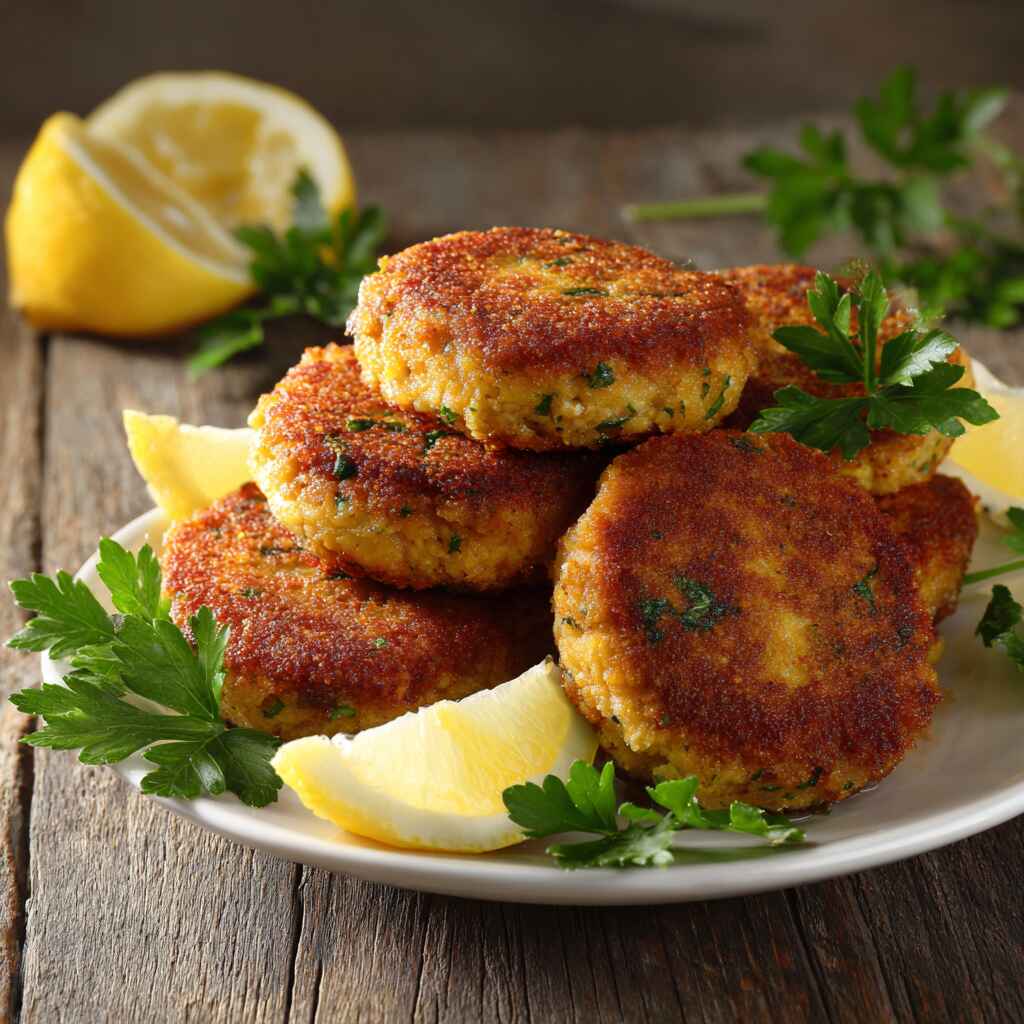This article explores how to make the ultimate salmon cakes — crisp on the outside, tender inside, and packed with flavor. Whether you’re working with fresh or canned salmon, this recipe is approachable, nourishing, and perfect for weeknights. You’ll learn the best techniques to bind your cakes without falling apart, creative sauces to serve them with, and how to keep them irresistibly moist. Plus, I’ll share a heartwarming memory from my kitchen that makes this dish extra special. If you’re looking for a simple yet satisfying way to serve salmon, this guide has everything you need.
The Story Behind My Favorite Salmon Cakes
Why Salmon Cakes Matter in My Kitchen
Growing up, salmon cakes weren’t just a weeknight dinner — they were comfort on a plate. I remember my mom shaping those delicate rounds while chatting with me about school, her hands moving with practiced ease. She always used leftover baked salmon or sometimes even canned, reminding me that great meals don’t require fancy ingredients. That’s what makes salmon cakes so beautiful: they’re humble, adaptable, and deeply satisfying.
Now, when I make salmon cakes in my own kitchen, it’s a moment of pause. I hear her voice, see the sizzle of the skillet, and breathe in that familiar aroma. I often serve them with my homemade garlic aioli or a tangy Greek yogurt dill sauce — it’s my twist on tradition. These salmon cakes, infused with lemon, parsley, and a bit of onion, are my go-to when I want something hearty yet light.
Not only are they rich in protein and omega-3s, but they’re also pantry-friendly. Whether you’ve got a fresh fillet or a can in the cupboard, you can whip them up in under 30 minutes. And if you’ve never tried baking them instead of frying, you’re in for a crispy surprise.
What Makes Salmon Cakes So Special?
Salmon cakes strike that rare balance between everyday and elevated. They can be rustic or dressed up with a fancy sauce. The key is freshness: using lemon zest, a splash of Dijon, and tender flakes of salmon keeps each bite bright and flavorful. And for those wondering, yes — salmon cakes can be made entirely from canned salmon, making them budget-friendly without sacrificing taste. When bound properly, with breadcrumbs or crushed crackers, and chilled briefly before cooking, they’ll hold their shape perfectly. We’ll cover all of that in the next section.
How to Make Salmon Cakes That Don’t Fall Apart
The Secret to Perfectly Bound Salmon Cakes
The most common frustration with salmon cakes? They fall apart. The solution? Balance moisture with structure. Start by draining your salmon well—whether it’s canned or freshly cooked. Then, bind it with a mixture of eggs, a touch of mayo, and just enough breadcrumbs or crushed crackers to hold it together without drying it out. I like using panko crumbs for extra crispiness, but even leftover rice or mashed potatoes work beautifully.
Add finely chopped onion, parsley, and a teaspoon of Dijon for punch. Then chill the mixture for 15–30 minutes before shaping—this helps the ingredients firm up and makes the cakes easier to cook. When shaping, don’t over-handle. Just press gently and evenly into discs.
Fresh vs. Canned Salmon: Does It Matter?
You can make excellent salmon cakes with either. If using fresh salmon, bake or pan-sear it and flake it once cooled. For convenience, canned salmon is absolutely fine, just make sure to remove the bones and skin if you’re not a fan of texture. Canned salmon tends to be saltier, so adjust your seasoning accordingly.
I personally lean into the ease of canned salmon on busy nights and fresh when I want a weekend treat. Both give great results. If you’re exploring other canned seafood meals, try the herbed tuna patties they follow the same logic and are equally satisfying.
Want another flaky seafood favorite? My garlic butter tilapia is a go-to for a quick weeknight dinner.
Quick Tip Table: Binding Troubleshooting| Problem | Fix |
|---|---|
| Falling apart when frying | Add more binder (egg/breadcrumbs) and chill longer |
| Too dry | Reduce breadcrumbs, add 1 tsp mayo or Greek yogurt |
| Bland taste | Add lemon zest, Dijon, or fresh herbs |
Flavor Twists & Sauce Pairings for Salmon Cakes
How to Customize Your Salmon Cakes
Salmon cakes are versatile — they’re a blank canvas for flavor. Want a Mediterranean vibe? Add crumbled feta, chopped olives, and dill. Craving spice? Try diced jalapeños, cumin, and a pinch of cayenne. For a Southern twist, I sometimes add a bit of Old Bay seasoning and a spoonful of finely chopped celery for crunch.
The best part? You can adjust these mix-ins without compromising texture. The key is keeping the moisture and binder ratio stable. Fresh herbs like parsley or green onion make a huge difference in brightness, especially if you’re using canned salmon.
You can also switch up the coating: swap out breadcrumbs for crushed cornflakes or almond flour if you’re going gluten-free. Want a lower-carb version? Try mixing in mashed cauliflower instead of breadcrumbs. It’s surprisingly delicious and still holds together beautifully.
I often rotate between my shrimp tacos when I want bold spices and these salmon cakes when I need something cozy but quick.
The Best Sauces for Serving Salmon Cakes
A good sauce takes salmon cakes from tasty to unforgettable. Here are a few favorites to serve on the side or drizzle right on top:
- Lemon Dill Yogurt Sauce: Mix Greek yogurt with lemon juice, fresh dill, and garlic. Refreshing and tangy.
- Classic Tartar Sauce: Mayo, pickles, lemon, and a little mustard — perfect if you love a traditional taste.
- Chimichurri: Bright and herby. My chimichurri sauce adds a punchy contrast to the rich salmon.
- Spicy Aioli: Mix mayo with sriracha or chipotle for a smoky heat.
If you’re in the mood for variety, I’d also recommend my baked cauliflower recipe as a perfect side dish. Its crispy edges pair so well with the tender texture of the cakes.
Want more zesty sauces? Check out my stir-fry sauce guide — it’s a great base for customizing dips, too.
Serving, Storing & Reheating Salmon Cakes
What to Serve with Salmon Cakes for a Complete Meal
Salmon cakes are the star, but what you serve with them matters just as much. For a weeknight dinner, I love pairing them with a crisp green salad or a warm grain like quinoa or rice. Add roasted veggies — like my crispy roasted chickpeas or stuffed peppers with rice — and you’ve got a balanced, vibrant plate.
If you’re aiming for brunch or lunch, tuck the cakes into a toasted brioche bun with lettuce, tomato, and a smear of lemon aioli. They’re also wonderful over greens in a salmon cake salad with creamy dressing and avocado slices.
For a family-style dinner, serve them alongside pita bread pizza for a fun “fish-and-flatbread” night — kids love the combo. Or go light and fresh with a big bowl of quinoa salad and some lemon wedges on the side.
How to Store, Freeze, and Reheat Like a Pro
Got leftovers? You’re in luck — salmon cakes reheat beautifully if handled right. Once cooled, store them in an airtight container in the fridge for up to 3 days.
To freeze, place cooled cakes on a baking sheet and freeze until solid, then transfer to a zip-top bag. They’ll keep for 2–3 months. To reheat, bake at 375°F for 10–12 minutes from thawed (or 20 minutes from frozen) to crisp them up without drying them out.
Avoid microwaving if you want them crispy — the oven or air fryer is your best friend here. You can also gently pan-fry them again in a touch of oil.
I like doubling the batch and freezing half — it’s like a gift to my future self. Just like I do with my beef stew pasta recipe, these are the kind of dishes you’ll be thrilled to pull out of the freezer on a busy night.
Frequently Asked Questions About Salmon Cakes
What are salmon cakes made of?
Salmon cakes are made from flaked salmon (fresh or canned), eggs, breadcrumbs or crackers, onions, herbs, and seasonings. These ingredients are combined and shaped into patties, then pan-fried, baked, or air-fried until golden and crisp.
Can I use canned salmon for salmon cakes?
Yes, canned salmon works wonderfully in salmon cakes. It’s affordable, convenient, and just as flavorful. Be sure to drain it well and remove bones or skin if desired. Adjust salt and seasoning, as canned salmon can be slightly saltier than fresh.
How do you keep salmon cakes from falling apart?
To prevent salmon cakes from falling apart, use enough binders like egg and breadcrumbs. Chill the mixture before shaping, and avoid overmixing. A firm, well-balanced mixture holds together better when cooked.
What is the best sauce to serve with salmon cakes?
The best sauces for salmon cakes include lemon dill yogurt sauce, classic tartar, spicy chipotle aioli, or chimichurri. Each adds contrast and moisture, enhancing the overall flavor and texture.
Conclusion
Salmon cakes are a timeless comfort food, blending simplicity with soul. Whether you use fresh fillets or a can from the pantry, the results are satisfying and flavorful. You now have everything to make them perfectly — firm, crisp, and full of personality.
From serving ideas and storage tips to custom flavor twists and sauces, this guide ensures you can make salmon cakes your own. Just like many of my recipes, they reflect the heart of home cooking — unfussy, delicious, and always welcome at the table.
If you loved this, try more comforting recipes like my beef with broccoli or creamy parmesan one-pot chicken and rice.

